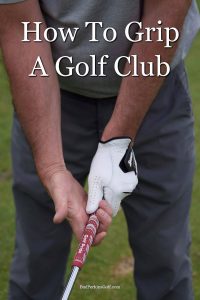 Using the proper golf grip can make a big difference to how well you perform. Do you know the correct way to hold a golf club?
Using the proper golf grip can make a big difference to how well you perform. Do you know the correct way to hold a golf club?
Many new golfers give little thought to as to how they actually hold their clubs. After all, how difficult is it and what does it matter what form your grip takes? Well actually, using a proper golf grip is one of the most vital factors in successfully hitting the ball well.
If I tell you that it’s one of the fundamentals of the game that even pros spend a lot of time on, then that should give you some idea of how important it is. The long and short of it is this: get a good grip on the best way to hold your clubs and you’ll be well on the way to better results.
That’s all very well of course, but just what is a proper golf grip? Well, there are two things to keep in mind. Firstly, you want to use the type of grip that is most comfortable for you personally. Secondly, where you place the club in the palms of your hand is important if you want good results.
Let’s now take a closer look at each of these aspects of how to grip a golf club. First we’ll consider the different types of grip you can use. There are three main types, two of which are more popularly used by pros. Try each out and see which is most comfortable for you. Here they are…
Proper golf grip options
The interlocking grip
The interlocking golf grip is the most commonly used. It gets its name from the fact that you interlock your right hand pinky with your left hand index finger (for left-handed golfers it’s the other way around). Golfers like this grip because your hands are physcially joined and there’s less chance of them coming apart during your back swing. The grip feels comfortable and your hands feel as one.
The overlapping or Vardon grip
The second most popular kind of grip is the overlapping grip which is also often called the Vardon Grip, after Harry Vardon, an English golfer who was famous in the early twentieth century. With this grip, instead of your pinky and index fingers being interlocked, you rest the pinky finger of your right hand between your left hand’s index and middle fingers.
Because there’s no interlocking, the overlapping grip doesn’t feel as secure. That said, this grip is used by some top golfers.
The baseball grip
The baseball grip is one that you’ll often see new golfers using. That’s because they don’t know any better; if they did, they probably wouldn’t use it. This grip is also often known as the ten-fingered grip. None of your fingers interlock or overlap when you use this grip. Rather one hand is placed just below the other and all of your fingers touch the club (hence why it’s referred to as the ten-fingered grip).Your right hand pinky finger rests up against your left hand index finger.
When using this grip, it’s very easy for your hands to separate during your swing and if that happens you’re not going to hit good shots. So if you do decide to use the baseball grip, which I don’t recommend unless you really can’t get a handle on either of the other grips described above, you’ll have to make a conscious effort to ensure you keep your hands together.
Palm placement
Once you’ve worked out which type of grip is most comfortable and are happy with your choice, the next consideration is how you place the club in the palms of your hand. A mistake that’s often made by new golfers and high-handicappers in general is that they use their palms too much when gripping the club.
Although you obviously have to use your palms to some extent, you really want to make sure club butt runs as close to your fingers as you can. Using your fingers in this way will give you much more control and let you generate more power in your shots.
Summary
If you get instruction from any golf pro, they’re almost certain to start by teaching you to use a proper golf grip. That’s how important it is! Use the above tips on how to grip a golf club correctly and you’ll soon be on the road to better scores.
I recommend you experiment with both the overlapping and interlocking grips while you’re on the practice range. See which one feels most comfortable and secure for you and adopt that one going forward.
Good luck on the course!

